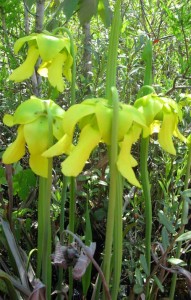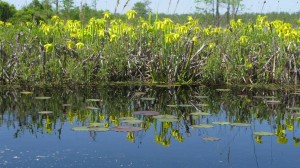A natural garden is worth a paddle
By Ken Moore
“I thought I’d died and gone to heaven!†That’s an expression I learned years ago to describe anything wonderful beyond description. Seeing acres and acres of yellow pitcher plants, trumpets, Saraccenia flava, flowering on the inner ring of a pond cypress, Taxodium ascendens, swamp, is definitely such an experience.
Three lucky couples from Carrboro and Chapel Hill joined Robert (Muskie) and Vikki Cates for a paddle on Horseshoe Lake in Suggs Mill Pond Game Land southeast of Fayetteville two weeks ago.
Muskie and Vikki paddle a lot. Muskie plans his trips well in advance and he has objectives, like on this last one: “I think we’ll catch the pitcher plants in flower.†He was dead on target. In all my years of botanizing in wild places, I’ve never seen anything like this! Thousands of yellow-flowered trumpets on floating mats of sphagnum moss encircling Horseshoe Lake were a died-and-gone-to-heaven surprise.
Paddling on that horseshoe-shaped Carolina bay lake was like stepping way back in time to experience wild nature before humans had progressed very far. And there are hundreds of Carolina bays scattered across the coastal plain.
Carolina bays are curious elliptical-shaped configurations, all with a northwest to southeast orientation. These distinctively shaped landscapes are easily identified on satellite photos. Most of them are densely vegetated evergreen shrub bogs or bay forests. A few, such as Singletary Lake and Jones Lake, are still open water, bordered by swamp or bay forests. Horseshoe Lake’s distinguishing horseshoe shape results from vegetation slowly filling into the lake center from the northwestern end.
Many theories have been proposed for the origin of the Carolina bays, from a giant dinosaur-age meteor shower to underwater wave action back when ancient seas covered the land. The engaging debate continues to this day.
Carolina bay evergreen shrub bogs and bay forests are characterized by a couple of dozen mostly evergreen trees and shrubs that, in the absence of flowers, can be a challenge to identify. Some of our fine garden plants like sweet bay magnolia, inkberry holly and Virginia willow come from this assortment of plant communities.
These wild areas are interesting to explore, and spectacular gardens are frequently found in sunny transition zones, particularly along the edges of the lakes, such as we found at Horseshoe.
After flowering, the two-foot-tall trumpet leaves will be spectacular all around the lake during the growing season. I’d like to be paddling there right now to see extensive mats of bladderworts, Utricularia spp., with tiny yellow flowers held a couple of inches above the lake surface. A few weeks later, that same lake surface will be covered with thousands of native white-flowered water lilies, Nymphaea odorata. All definitely worth a paddle!
If you don’t have a trip planner friend like Muskie, it’s not too difficult to plan your own natural gardens exploration. Check out Exploring North Carolina’s Natural Areas, edited by Dirk Frankenberg. It contains specific descriptions with suggested field trips for numerous natural areas throughout the state.
Whether driving, walking, biking or paddling, nature’s gardens are worth the effort!




Comments are closed.